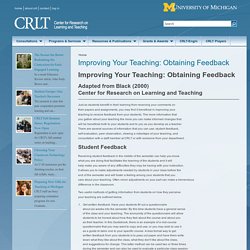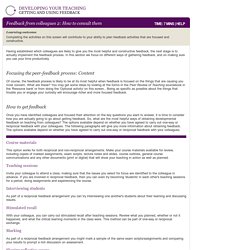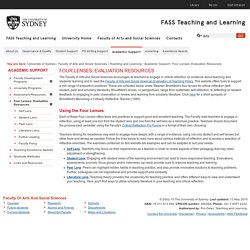

Improving Your Teaching: Obtaining Feedback. Adapted from Black (2000) Center for Research on Learning and Teaching Just as students benefit in their learning from receiving your comments on their papers and assignments, you may find it beneficial in improving your teaching to receive feedback from your students.

The more information that you gather about your teaching the more you can make informed changes that will be beneficial both to your students and to you as you develop as a teacher. There are several sources of information that you can use: student feedback, self evaluation, peer observation, viewing a videotape of your teaching, and consultation with a staff member at CRLT or with someone from your department. Student Feedback Receiving student feedback in the middle of the semester can help you know what you are doing that facilitates the learning of the students and it will help make you aware of any difficulties they may be having with your instruction. Get written feedback. Self Reflection Peer Observation References. Feedback from colleagues 2: How to consult them. Having established which colleagues are likely to give you the most helpful and constructive feedback, the next stage is to actually implement the feedback process.

In this section we focus on different ways of gathering feedback, and on making sure you use your time productively. Focusing the peer-feedback process: Content Of course, the feedback process is likely to be at its most helpful when feedback is focused on the things that are causing you most concern. What are these? You may get some ideas by looking at the forms in the Peer Review of Teaching sourcebook in the 'Resource bank' or from doing the 'Optional activity' on this screen.. Nine steps to quality online learning: Step 9: Evaluate and innovate. Measuring Engagement: Learning Analytics in Online Learning. Four Lenses: Evaluation Resources - Teaching and Learning. The Faculty of Arts and Social Sciences encourages its teachers to engage in critical reflection on evidence about teaching and students' learning and to read the Faculty of Arts and Social Sciences Evaluation of Teaching Policy.

This website offers tools to support a rich range of evaluation practices. These are collected below under Stephen Brookfield's four lenses for critical reflection (self, student, peer and scholarly literature). Brookfield's lenses, or perspectives, range from systematic self-reflection, to reflecting on student feedback, to engaging in peer observation or review, and learning from scholarly literature. Click here for a short synopsis of Brookfield's Becoming a Critically Reflective Teacher (1995). Each of these Four Lenses offers tools and practices to support good and excellent teaching. Teachers striving for excellence may wish to engage more deeply with a range of evidence, using not only student and self lenses but other tools and lenses as needed.
HATTIE4.avi. Aropä. Aropä is a web-based system which supports peer review activities.

In a peer-review activity, an instructor sets students an assignment. After students have submitted their assignment, they comment on the submissions from other students. Once the review process is complete, students read the comments their peers have made on their own submission. Aropä is used extensively at the University of Auckland and Glasgow University. It is also used world-wide, with regular use at the following institutions: Franklin University Cyberjaya University College of Medical Sciences Sheffield University Curtin University Robert Gordon University Glasgow Caledonian University Washington & Lee University Virginia Tech In the 2014/5 academic year, just over 5% of the entire student body of the University of Glasgow used the system to review their peers' work.
Aropä has been used in classes in the following subject areas: EllisBroadeningBJET_submission.pdf.
Quality Assurance. Four Lenses: Evaluation Resources - Teaching and Learning. Course_design_checklist.pdf. Sandbox:Phase Five Evaluation. Evaluation phase takes place once the course has successfully come to an end for the first time (sometimes this phase might happen while the course is running depending on the urgency of the issues and demands/feedback from students).

In order to prepare the course for the second offering, the course development team will meet again to evaluate the course based on the first offering, the student evaluations, peer feedback, instructor's notes and reflection, feedback provided by the course instructor/course author and the team. [Expand] Note: Tasks to be completed by the project manager/instructional designer: After the first offering of a course, the Project Manager/Instructional Designer may ask to meet with the course author/instructor to debrief how the course went. Supporting Quality Assurance Documentation The online course evaluation links below offer a range of rubrics and guidelines to assist with the development of effective practices for evaluating online courses. License. Www.online.pitt.edu/faculty/documents/SelfReviewGuide.pdf.